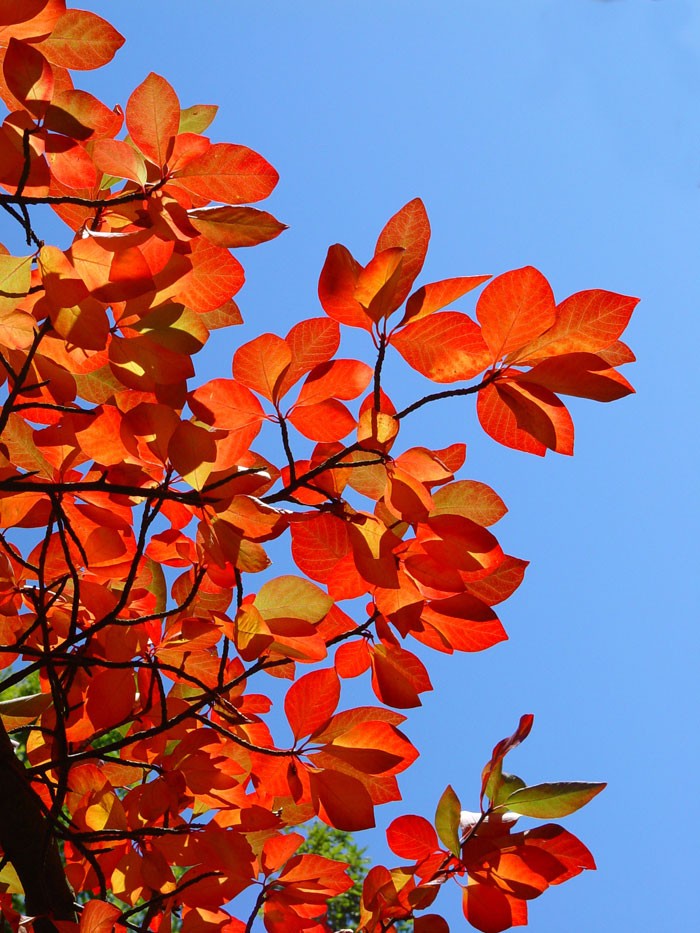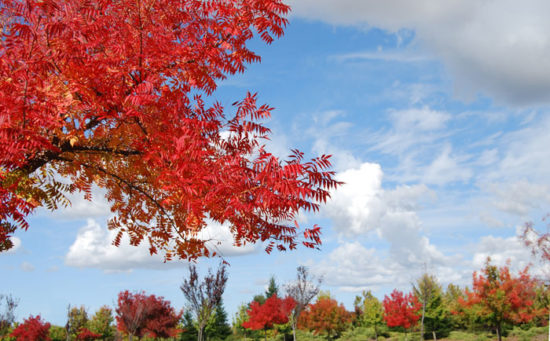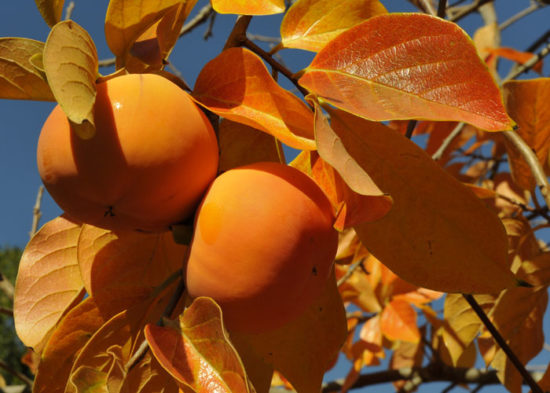Updated:February28,2024 Here at NHG, we know you love pretty blooms that are easy to plant,…
Orange & Red Leaved Trees to Plant for Spectacular Fall Colors
Updated: February 28, 2024
The weather may not cooperate, but colorful fall foliage helps Texans feel like the fall season has reached DFW. If you want to plant your own autumnal show stopper at home, consider one of these three favorites from NHG:

1. Black gum or ‘Tupelo’ (Nyssa sylvatica)
Called “one of the best and most consistent native trees for fall color” by tree expert Michael Dirr (Arbor Day Foundation) this north American native species makes a durable and reliable landscape specimen. It’s a particularly valuable shade tree, reaching up to 50′ in height and 30′ in width (so plant accordingly with regard to surrounding structures and power lines). The bark is said to resemble alligator hide, and while the tiny flowers are insignificant, they’re still a valuable source of nectar for bees and other pollinating insects. Most of all, Tupelo trees are planted for their vibrant fall color–with single branches boasting brilliant shades of red, gold, orange, purple and green. They’re tolerant of wet soils, too, making them a great choice for rain swales or seasonal creek placements.
Where do Tupelo Trees Fit the Best?
When choosing trees for fall color, it’s important to consider not only the vibrancy of their foliage but also their size, maintenance needs, and overall suitability for your landscape. In addition to the black gum, several other options can provide stunning autumn hues, like the Chinese Pistache, and Japanese persimmon mentioned below.
One popular choice is the sugar maple (Acer saccharum), known for its bright orange and red leaves. This tree can reach up to 60 feet in height and is best suited for larger landscapes where it has room to grow. Another great option is the sweet gum (Liquidambar styraciflua), which offers a mix of red, orange, and purple leaves. Sweet gums can also reach significant heights, so they are best suited for spacious yards.

2. Chinese Pistache (Pistacia chinensis)
While not native to north America, Chinese Pistache are well-behaved, low-maintenance, and remarkably quick to grow–in fact, it’s gained momentum as a landscape choice for municipal and commercial installations over the last decade. It’s been highly regarded by experts at Texas A&M and Oklahoma State Universities as one of the finest shade trees for our area, and is now listed as a Texas Superstar® and was the first shade tree to receive the coveted “Earth–Kind” designation from the Texas Agricultural Extension Service for its high levels of genetic resistance to insect and disease problems. It’s considered fast growing (2-3′ per year) to a height of 50′ with a mature width of 30′. Experts recommend choosing your plants at nurseries during fall–not only because it’s the best time to plant, but to be sure you’re getting a specimen that’s genetically inclined to put on a good color show.
How to take care of the Chinese Pistache
Taking care of Chinese Pistache trees is relatively easy, making them a great choice for homeowners looking to add some vibrant fall color to their landscape. Here are some tips on how to care for these beautiful trees:
- Sun and Water: Chinese Pistache trees thrive in full sun but can also tolerate partial shade. They prefer well-draining soil and should be watered regularly, especially during the first year after planting to help establish their root system. Once established, they are drought-tolerant and can handle periods of dryness.
- Pruning: Chinese Pistache trees have a naturally symmetrical shape, so minimal pruning is required. Simply remove any dead or diseased branches as needed to maintain their health and appearance.
- Fertilizing: While Chinese Pistache trees are relatively low-maintenance, they can benefit from occasional fertilization. You can use a balanced fertilizer in the spring to help promote healthy growth and vibrant foliage.

3. Japanese Persimmon (Diospyros kaki)
While this is easily the most high-maintenance of the group, it’s also the smallest, and it provides succulent fruit in early winter. Persimmon trees (common Japanese varieties include ‘Fuyu’, ‘Tamopan’ and ‘Hachiya’) make unique specimen trees with a lovely branching habit, typically reaching only 20′ or so feet at maturity with similar spread. Their large, lazily-held leaves dazzle with brilliant, fiery shades in fall, leaving behind the large, red-orange fruit that’s an ornament unto itself. Persimmon trees won’t mind a bit of protection from the hottest afternoon sun, and they’ll appreciate a bit more TLC during their first few years–but seeing an established specimen in full color makes the effort worth it.
What can you do with a Japanese Persimmon Fruit?
Japanese persimmons are not only beautiful trees for fall color, but they also produce delicious fruit that can be enjoyed in a variety of ways. Here are some ideas for what you can do with Japanese persimmon fruit:
- Eat them fresh: Japanese persimmons can be eaten fresh like apples or pears. The y have a sweet, honey-like flavor and a unique texture that makes them a delicious snack.
- Bake with them: Japanese persimmons can be used in baking recipes, such as cakes, breads, and muffins. They add a natural sweetness and moisture to baked goods.
- Make preserves: Japanese persimmons can be made into preserves, jams, or chutneys. Their sweet flavor pairs well with spices like cinnamon, ginger, and cloves.
- Add them to salads: Diced Japanese persimmons can add a sweet and juicy element to salads, balancing out bitter greens or tangy dressings.
If you’ve been admiring fall foliage trees and wishing you had one in your landscape, they’re the perfect place to start!
North Haven Gardens Can Help
Visit us in the garden center for more ideas, inspiration, and the best plants in town or sign up for our weekly newsletter for NHG updates, new arrivals & timely tips!
Read More about Fall Gardening:

